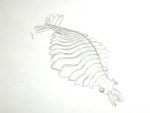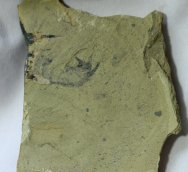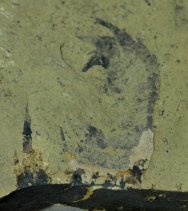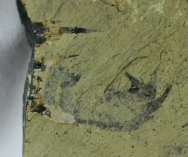 Description:
This impressive specimen comes from the Early Cambrian Heilinpu
Formation deposits near Anning, in Kunming County, Yunnan Province,
China, The discovery of the Chengjiang Biota by Hou Xian-guang in
1984 opened a window onto a remarkable array of lifeforms from what
is termed the Cambrian Explosion. The diversity of soft-tissue fossils
is astonishing: algae, medusiforms, sponges, priapulids, annelid-like
worms, echinoderms, arthropods (including trilobites), hemichordates,
chordates, and the first agnathan fish make up just a small fraction
of the total. Numerous problematic forms are known as Description:
This impressive specimen comes from the Early Cambrian Heilinpu
Formation deposits near Anning, in Kunming County, Yunnan Province,
China, The discovery of the Chengjiang Biota by Hou Xian-guang in
1984 opened a window onto a remarkable array of lifeforms from what
is termed the Cambrian Explosion. The diversity of soft-tissue fossils
is astonishing: algae, medusiforms, sponges, priapulids, annelid-like
worms, echinoderms, arthropods (including trilobites), hemichordates,
chordates, and the first agnathan fish make up just a small fraction
of the total. Numerous problematic forms are known as  well,
some of which may have represented failed attempts at diversity
that did not persist to the present day. well,
some of which may have represented failed attempts at diversity
that did not persist to the present day.
This
is the grasping arm of one of the “Terrors Of The Cambrian”,
Amplectobelua symbranchaiata. The members of this group of enigmatic
creatures are known from Asia, Australia, Europe, and North America,
and are thought by many to be closely allied with the Arthropda,
a position not held by all researchers. As of the publication
of Hou’s book in 2004, some 30 examples were known, most
being grasping arms like this one. The spiniferous grasping appendages
are strongly suggestive of its carnivorous habits; some trilobites
from Utah bear evidence of bite marks that have been attributed
to its near relative Anomalocaris. The primary distinction between
the 2 genera is that the spines of Anomalocaris are branched,
while those on Amplectobelua are unbranched, as seen here. The
proximalmost spine is also greatly elongated.
Also
see: Chengjiang
Biota Fauna List Chengjiang
Fossils
|




